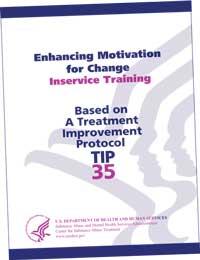Treatment Update:
Increasing Motivation
 By Riggin Waugh By Riggin Waugh
To help counselors and care providers motivate substance users to begin and continue treatment, SAMHSA’s Center for Substance Abuse Treatment (CSAT) recently released a new training manual, Enhancing Motivation for Change Inservice Training.
Based on Treatment Improvement Protocol (TIP) 35, Enhancing Motivation for Change in Substance Abuse Treatment, the new manual provides needed basic training support for treatment staff and peer counselors. The training is particularly valuable for new counselors or for clinicians who are unfamiliar with the basic concepts and strategies of motivational enhancement.
“This is the first of several TIP inservice training manuals being developed under the Knowledge Application Program,” said Christina Currier, Knowledge Application Program Project Officer at CSAT. “The user-friendly format of the manual enables use by nonprofessional trainers, such as program supervisors, and encourages interaction with training participants.”
Back to Top
What Is Motivational Enhancement Therapy?
Motivational enhancement therapy is client-centered counseling that helps individuals explore and resolve problems they have with change. Motivation-enhancing techniques help an individual participate in his or her own treatment for substance abuse. Results include reducing substance use, maintaining higher abstinence rates, and adjusting more easily in social settings.
Back to Top
The Manual
The trainer’s manual includes 10 training modules and 1 followup module. Each module—1½ to 2 hours in length—includes presentation instructions, PowerPoint slides (which can be copied onto overhead transparencies), homework assignments, and participant handouts.
The training approach includes presentation, discussion, group or partnered practice exercises, and between-session assignments.
The training teaches participants about change theory and motivational strategies, ways to assess a client’s readiness for change, and also helps participants develop overall skills for enhancing client motivation. Between-session exercises encourage practicing these new skills and integrating them into sessions with clients.
The flexible-module approach of the inservice manual allows the training to be delivered on consecutive days or offered over several weeks. Longer periods between sessions allow participants more time to practice techniques and integrate them into their counseling styles.
Back to Top
Highlights
SAMHSA’s new training curriculum presents a thoughtful mix of key concepts and interactive exercises that reinforce the evidence-based knowledge offered in TIP 35.
For example, in the curriculum’s third module, “Motivation and Intervention,” the trainer explains reflective listening and demonstrates this complex and critical skill with a volunteer.
Participants then team with a partner to take turns offering simple reflections, repeating in their own words and in a neutral tone what they think the other person said.
On their paths to recovery, clients encounter the five stages of change—precontemplation, contemplation, preparation, action, and maintenance. In Module 4, “Basic Strategies of Motivational Enhancement,” clients role play a counseling session. Based on the “story” performed, the “audience” identifies the correct stage of change.
Back to Top
To Order
For a free copy of Enhancing Motivation for Change Inservice Training, contact SAMHSA’s National Clearinghouse for Alcohol and Drug Information at 1 (800) 729-6686 (English), 1 (877) 767-8432 (Español), or 1 (800) 487-4889 (TDD). Ask for Publication No. (SMA) 06-4190.
The training manual is available in PDF format from SAMHSA’s Knowledge Application Program (KAP) Web site. The entire training manual is available at http://kap.samhsa.gov/products/manuals/
tip35c/pdf/p_complete_manual.pdf. For separate modules, visit http://kap.samhsa.gov/products/manuals/tip35c/index.htm. 
Back to Top
TIP 35: Additional Resources
Online, SAMHSA’s Knowledge Application Program offers a full-text version of TIP 35 as well as quick-reference tools:
|
« Previous Article
Next Article »
Back to Top
|


